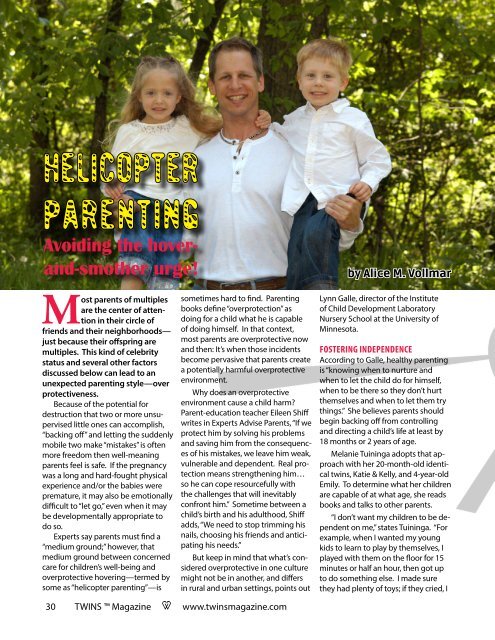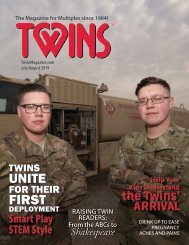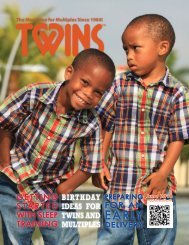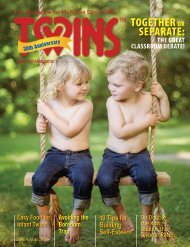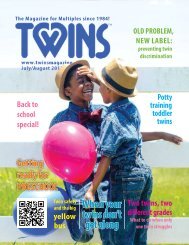SEP OCT 2017 3
You also want an ePaper? Increase the reach of your titles
YUMPU automatically turns print PDFs into web optimized ePapers that Google loves.
Helicopter<br />
Parenting<br />
Avoiding the hoverand-smother<br />
urge!<br />
by Alice M. Vollmar<br />
Most parents of multiples<br />
are the center of attention<br />
in their circle of<br />
friends and their neighborhoods—<br />
just because their offspring are<br />
multiples. This kind of celebrity<br />
status and several other factors<br />
discussed below can lead to an<br />
unexpected parenting style—over<br />
protectiveness.<br />
Because of the potential for<br />
destruction that two or more unsupervised<br />
little ones can accomplish,<br />
“backing off” and letting the suddenly<br />
mobile two make “mistakes” is often<br />
more freedom then well-meaning<br />
parents feel is safe. If the pregnancy<br />
was a long and hard-fought physical<br />
experience and/or the babies were<br />
premature, it may also be emotionally<br />
difficult to “let go,” even when it may<br />
be developmentally appropriate to<br />
do so.<br />
Experts say parents must find a<br />
“medium ground;” however, that<br />
medium ground between concerned<br />
care for children’s well-being and<br />
overprotective hovering—termed by<br />
some as “helicopter parenting”—is<br />
sometimes hard to find. Parenting<br />
books define “overprotection” as<br />
doing for a child what he is capable<br />
of doing himself. In that context,<br />
most parents are overprotective now<br />
and then: It’s when those incidents<br />
become pervasive that parents create<br />
a potentially harmful overprotective<br />
environment.<br />
Why does an overprotective<br />
environment cause a child harm?<br />
Parent-education teacher Eileen Shiff<br />
writes in Experts Advise Parents, “If we<br />
protect him by solving his problems<br />
and saving him from the consequences<br />
of his mistakes, we leave him weak,<br />
vulnerable and dependent. Real protection<br />
means strengthening him…<br />
so he can cope resourcefully with<br />
the challenges that will inevitably<br />
confront him.” Sometime between a<br />
child’s birth and his adulthood, Shiff<br />
adds, “We need to stop trimming his<br />
nails, choosing his friends and anticipating<br />
his needs.”<br />
But keep in mind that what’s considered<br />
overprotective in one culture<br />
might not be in another, and differs<br />
in rural and urban settings, points out<br />
Lynn Galle, director of the Institute<br />
of Child Development Laboratory<br />
Nursery School at the University of<br />
Minnesota.<br />
fostering indePendence<br />
According to Galle, healthy parenting<br />
is “knowing when to nurture and<br />
when to let the child do for himself,<br />
when to be there so they don’t hurt<br />
themselves and when to let them try<br />
things.” She believes parents should<br />
begin backing off from controlling<br />
and directing a child’s life at least by<br />
18 months or 2 years of age.<br />
Melanie Tuininga adopts that approach<br />
with her 20-month-old identical<br />
twins, Katie & Kelly, and 4-year-old<br />
Emily. To determine what her children<br />
are capable of at what age, she reads<br />
books and talks to other parents.<br />
“I don’t want my children to be dependent<br />
on me,” states Tuininga. “For<br />
example, when I wanted my young<br />
kids to learn to play by themselves, I<br />
played with them on the floor for 15<br />
minutes or half an hour, then got up<br />
to do something else. I made sure<br />
they had plenty of toys; if they cried, I<br />
30 TWINS Magazine A www.twinsmagazine.com


